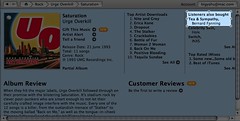Pardon the saucy headline but in the last few weeks' talking to potential investors and business partners, a number of times we've come up against a central question:
how many handsets does your software run on?It's a question that's meant to give a quick indication of (a) how many people are actually using our software on their phone; and (b) how many people
could use our software on their phone.
Critical stuff for companies like Bluepulse with a mobile internet application to take to market, as central to the mobile app space as, say, circulation figures are in magazine publishing, or quarterly shipments in personal computing. But as with circulation or quarterly shipments, there are a number of ways to answer what appears to be a simple question - none of them straightforward - and unlike magazine circulation or PC shipments, there's no independent auditor you can quote.
Unlike some mobile applications, the bluepulse client on your phone connects to our server each time you launch it, so we have some clear numbers on not just how many people have downloaded it, but also how often they've been using it, for how long, and for what purposes.
However, it's the "how many people
could use your software on their phone" where we hit problems.
We can establish, if we pay an industry research company enough, how many different handset models have been released, by all manufacturers, in all markets, by operating system. And probably, if we paid them some more, they could tell us roughly how many of each model have shipped worldwide to-date. Then it would just be a question of applying that number to the list of handsets we support on bluepulse, and there's your answer, right?
Wrong. You can't assume that people buy a handset and then use all the features on it, and that this behaviour is standard across age, sex and geography. One consumer will buy a brand-new phone packed with multimedia features and never use the phone for anything other than making calls, like all those SUV owners who've never taken their vehicle off-road. Another might stick with their Nokia 3200 until it has moss growing on it, and in the meantime will push the handset to its limits, accessing WAP sites, downloading content, and instant messaging with friends.
If I see another study that says, "youth the great adopters of mobile content" I will start tearing Ben's hair out if it doesnt also tell me what handsets they were on when they were busy adopting.
Here's a helpful insight from
www.tigerspike.com - an Australian mobile developer prepared to disclose some of the mobile consumer behaviour they see across their own mobile content. Keep in mind that Tigerspike develops mobile content for a broad youth market.
Their top 12 most popular handsets from 1 January 2005 to present are:
1. Nokia 3200
2. Nokia 6230
3. Nokia 7250
4. Sony Ericsson K700i
5. Nokia 6610
6. Nokia 3120
7. Motorola V3
8. Nokia 3220
9. Nokia 7610
10. Nokia 6600
11. Nokia 6100
12. Sony Ericsson T610
It's a significant list because a lot of these phones are running MIDP1, including, for instance, four out of the top five Nokia handsets in the list. If you're a keen follower of Mobile 2.0 companies you'll be unfamiliar with MIDP1 because Mobile 2.0 products typically don't support it. Many of them don't support MIDP2 either. Some of them are sufficiently bleeding-edge and driven by feature-over-functionality as to only support Symbian S60 handsets. Count the S60 handsets on the list. 'nuff said.
When we're out there talking about Bluepulse's growth potential, people don't want to hear, "we'll have millions of potential customers as soon as their carrier persuades them all to upgrade to a UIQ or S60 handset", they want to hear "we have millions of potential customers who can use our software on their phones today." Certainly, delivering functionality on a MIDP1 handset is not easy, and yes, it usually requires that you focus on function over features, but the mobile content industry should be here to sell content to the widest possible audience, not to sell new handsets for the handset manufacturers.
Technorati Tags:
Symbian,
S60,
Series 60,
Tigerspike,
bluepulse,
widget,
mobile 2.0,
web 2.0





